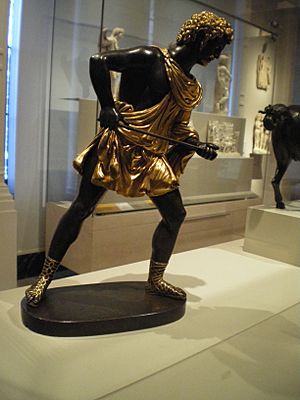Pier Jacopo Alari Bonacolsi facts for kids
Pier Jacopo Alari Bonacolsi (around 1460–1528) was a famous Italian sculptor from the Renaissance period. People called him L'Antico, which means 'The Ancient One'. This nickname was given because his artworks looked like the beautiful sculptures from ancient Rome and Greece. He was known for making small, very detailed bronze statues. These statues often had shiny gold parts and silver eyes, just like some old Greek sculptures.
Life of L'Antico
We don't have many records about Pier Jacopo Alari Bonacolsi's early life. He was probably born in Gazzuolo, a town near Mantua, Italy. He might have learned his skills as a goldsmith, which is someone who works with gold.
L'Antico found people who supported his art, especially the powerful Gonzaga family in Mantua. At first, he worked for Gianfrancesco Gonzaga and his wife Antonia del Balzo. He even made special medallions for their wedding in 1479.
After 1490, L'Antico worked mostly for Isabella d'Este, who was a very important art collector in Mantua. She was married to Francesco II Gonzaga. Mantua was a great place for artists because it had one of the best collections of ancient Roman sculptures and art in Italy.
L'Antico made many smaller copies of Roman sculptures. He also created new works that were inspired by the style of ancient times. His sculptures often had strong, clear body shapes, similar to the art of Andrea Mantegna, another famous artist from Mantua.
His bronze statues were known for being incredibly well-made. They were carefully cast, cleaned, and finished. He often used a special black color on his bronzes. L'Antico was one of the first sculptors to make copies of his own works. He did this by keeping his detailed wax models. His artworks were cool, refined, and a bit fancy. They were made to be admired closely in private art rooms, called studiolo, in noble homes.
L'Antico also worked as an art restorer. He helped fix old sculptures. You can even find his small signature on one of the large marble horse statues on the Quirinal Hill in Rome. His trip to Rome was important because he could study famous ancient statues like the Apollo Belvedere up close. This was the only time he is known to have traveled outside of Mantua.
He passed away in Gazzuolo in 1528.
In 2012, an exhibition of L'Antico's artworks was held at the Frick Collection in New York City.
Famous Artworks
- Medallions of Gianfrancesco Gonzaga and his wife Antonia del Balzo, 1479, National Gallery, Washington.
- Gonzaga Vase, 1481, Galleria Estense, Modena.
- Hercules and the Lernaean Hydra, a bronze medallion with gold parts. This was part of a series celebrating the hero Hercules, possibly to honor Ercole d'Este (who died in 1505). It is at the Bargello Museum, Florence. Other similar pieces are in Vienna and at the Victoria and Albert Museum.
- Meleager, c. 1484-1490, a bronze statue with some gold parts, at the Victoria and Albert Museum. The matching statue of the boar is missing.
- Eros, 1490, possibly a wedding gift for Isabella d'Este, at the Bargello Museum, Florence.
- Apollo Belvedere, a bronze statue with gold parts, at the Justus Liebighaus, Frankfurt. L'Antico may have seen the original Apollo Belvedere statue in Rome. Other versions of this sculpture are in the Fitzwilliam Museum, Cambridge, and the Ca' d'Oro, Venice.
- Venus Felix c. 1495, Kunsthistorisches Museum, Vienna. This is L'Antico's own artistic version, not just a copy.
- Hercules, 1496, a bronze statue with silver details, at the Museo Arqueológico Nacional, Madrid.
- Hercules, probably 1499, a bronze statue with gold and silver details, at the Frick Museum, New York.
- Seated Paris, c. 1500, at the Metropolitan Museum.
- Mercury, c.1500-1511, at the Bargello Museum, Florence.
- Cupid, firing an arrow, c. 1519, at the Rijksmuseum.
- Bust of a Young Man, c. 1520, at the J. Paul Getty Museum.
- Venus Caritas, c. 1520-1523, a bronze statue with gold and silver details, at the Walters Art Museum.
- Young Hercules, at the Louvre Museum.
See also
 In Spanish: Pier Jacopo Alari Bonacolsi para niños
In Spanish: Pier Jacopo Alari Bonacolsi para niños


